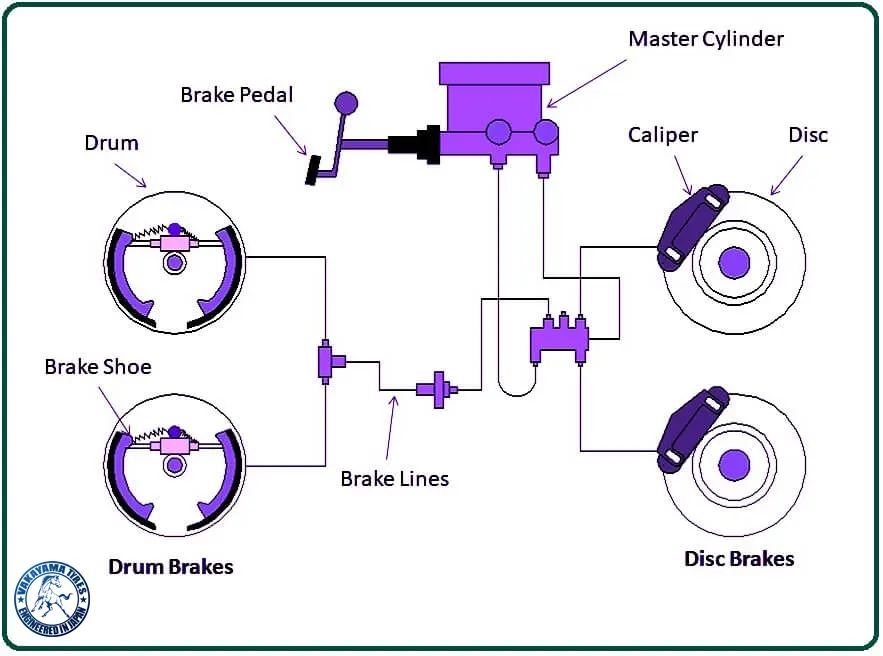Most modern cars have a four-wheel braking system, operated by a hydraulic braking system. These systems are the effective standard on all new vehicles, and modern hydraulic brakes are the culmination of over 100 years of advancements in braking technology.
The Theory of Hydraulic Brakes

Hydraulic Brakes work in accordance with Pascal’s Law, a law of fluid dynamics established by Blaise Pascal and published in 1663. It states that “a pressure change at any point in a confined incompressible fluid is transmitted throughout the fluid such that the same change occurs everywhere.”
A hydraulic brake system is composed of cylinders and tubes filled with incompressible oil. The cylinders will have the same volume, but different diameters, and different cross-section areas. In a system with two cylinders, the cylinder connected to the brake pedal is the master cylinder and will have a smaller diameter. The brake will be connected to the piston with the larger cross-section and is the slave cylinder. If the diameter of the master cylinder is half the diameter of the slave cylinder, the master cylinder will have a cross-section four times smaller. Because of this differential in the cross-section area, if 10 Newtons (N) of force are applied to the master piston, the slave piston will press with a force of 40 N.
The hydraulic brake system allows the force applied to the brake pedal to be multiplied, creating a much higher braking force than the driver could generate unaided.
The Design of Modern Hydraulic Brakes
All modern hydraulic braking systems are composed of the following key parts.
- The Brake Pedal – This is unsurprisingly a key part of the system. It is the brake pedal which transmits force from the driver to the fluid filled braking system. It’s connected to the Brake Master Cylinder.
- The Brake Master Cylinder – The master cylinder is a piston which, when pushed down by pressure on the brake pedal, pushes the brake fluid equally into all slave cylinders.
- The Brake Lines – These lines connect the master cylinder to the slave cylinders by the wheels, and transmit the brake fluid. They are typically made of steel.
- The Wheel Cylinders/Slave Cylinders – The wheel/slave cylinders transmit the force applied to the brake fluid in the system to the brakes.
- The Brake Drums/Rotors – All vehicles will either have rotors (disc brakes) or drums (drum brakes) or a mixture of the two types (e.g., discs on front axle, drums on rear). These are what the brake pads rub against to create the friction required to stop the car.
- The Brake Pads – Last but not least, the brake pads are the part which actually create the friction required to stop the vehicle. These are made of specialised heat resistant materials and should last for thousands of miles.
Understanding these parts, and the theory behind how they work, will help you identify faults with your hydraulic braking system and how to maintain it properly.
Common Faults with Hydraulic Braking Systems
By far the most common problem with hydraulic braking systems is when the system is low on brake fluid. As the system is designed to function as a closed system, it requires a consistent amount of brake fluid in the system to function correctly. Across the many connections between the cylinders and brake lines, small leaks can however develop. If your brakes are not responding as usual, you should get the system checked over for leaks.
A brake fluid leak can also cause problems with your brake pedal, though brake pedal issues can also have other causes.
If your brake pedal is sitting low, or sinking to the floor, then this is something you need dealt with straight away as it can cause an accident. Though these issues can be caused by low brake fluid, they can also be caused by worn brake linings or a worn master cylinder. These faults can be fixed by adjusting, cleaning, or replacing the shoe adjusters, or replacing the worn master cylinder.
If you are hearing squealing noises, then the issue will be with your brake pads or with vibrations between the calliper and disc pads. Replacing the brake pads or resurfacing the rotor(s) should fix this.
If you experience pulsating feedback through the brake pedal, this suggests that one or more of the rotors has warped. This will typically require replacement, or at least resurfacing, of the rotor(s).
Finally, it is possible that you will experience the brakes pulling to one side or the other when the pedal is depressed. This can be caused by several different underlying issues. The brakes may require adjustment, or there could be a contamination of the wheel linings. Issues with a cylinder wheel or calliper may be at fault, or it could be a problem with your wheel bearings. As with any issue which could be caused by any one of a handful of issues, it is best to have a trained mechanic identify the issue for you

